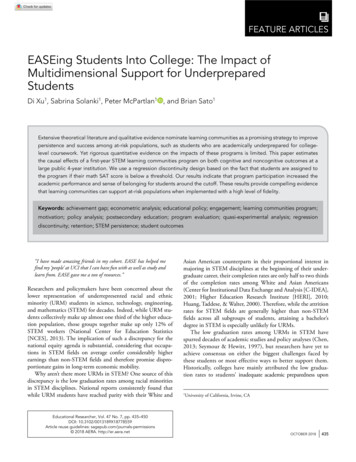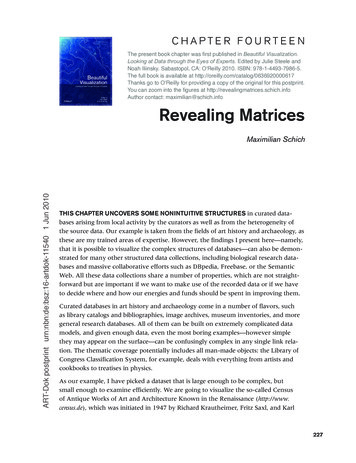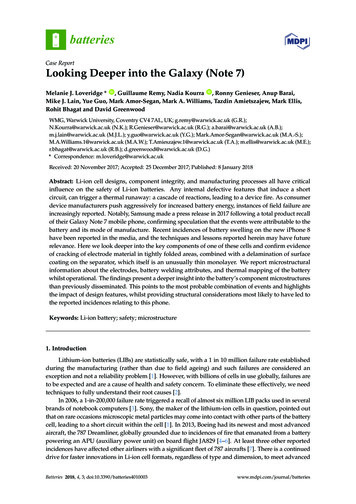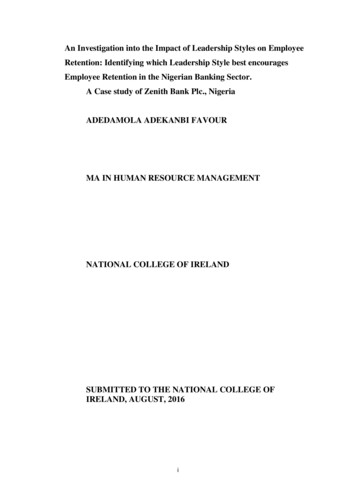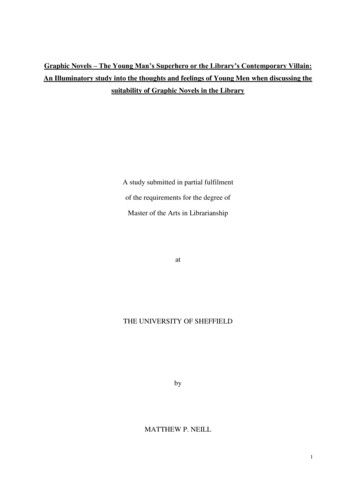
Transcription
Graphic Novels – The Young Man’s Superhero or the Library’s Contemporary Villain:An Illuminatory study into the thoughts and feelings of Young Men when discussing thesuitability of Graphic Novels in the LibraryA study submitted in partial fulfilmentof the requirements for the degree ofMaster of the Arts in LibrarianshipatTHE UNIVERSITY OF SHEFFIELDbyMATTHEW P. NEILL1
AbstractBackground. The literature reveals that great attention has been paid to graphic novels andother forms of drawn literature and their potential to find a place within the library andeducation. However, none of the previous studies concerned themselves with the views ofyoung adult males, favouring the views of librarians and young children instead.Aims. The study aimed to investigate the attitudes of working-class and new middle-classyoung adult males when discussing graphic novels and their potential suitability in the librarysetting.Methods. The author developed a semi-structured interview guide, based on the topicsdiscussed in previous studies. The interview was performed with 10 young adult maleparticipants from the Sheffield area.Results. The young adult males proved themselves to be competent and enthusiastic readers,as well as having an interest in the medium of drawn literature. All participants strongly feltthat drawn literature has a definite place in the library, as well as having the ability to appealto a wide range of readers and attract more users to the library. The participants showed thatthey believed drawn literature to be of equal value to written texts and that age and socioeconomic class should have no influence over peoples interest in the medium. As well as this,the views and findings of various authors featured in the literature review were furtherconfirmed by the similar views expressed by the young adult males.2
Chapter 11.1 IntroductionGraphic novels, Comic Books and Manga are all forms of drawn literature whichcontinue to be greatly popular with a wide range of readers. They have found themselves tobe the primary focus of several studies and investigations wishing to identify their suitabilityin the library setting and the education system. However, none of these have concernedthemselves with the attitudes that young adult males have towards drawn literature. Thisstudy will attempt to change that by illuminating the thoughts and feelings of young adultmales with a detailed qualitative study into the attitudes of a small sample.Comic books have had quite an interesting past, being both enjoyed and despised bylarge numbers of readers in America, Europe and Japan. Comic book publishers have hadgreat success, with the development of a wide range of independent and corporate publishersand an even wider range of publications and titles. However, comics and their publishershave also found themselves to be the target of moral crusades and scandal. In order toeffectively study the thoughts of young males on the medium of drawn literature and thepotential they have to become an accepted aspect of the library collection, it was felt that afoundation for thought should be offered in the form of a brief study of the medium itself, abrief history of the topic area, and the challenges and successes that have made comic booksand graphic novels what they are today.1.2 - A Brief Study of the Topic Area1.2.1 - Comic Book GenresAround forty years ago, the mainstream comic book publishers offered an extremelywide range of genres, with every popular taste being catered for. However, at the beginningof the 1960s, the super-hero comic quickly became the most dominant and well-known genre(although other popular genres of the time, like westerns and war comics, continued to sellwell). By 1970, the industry had become very homogenous and was dominated by DC andMarvel, the two biggest publishers. Genres like western, war, romance detective and funnycomics had practically disappeared, and the super-heroes of DC and Marvel had free reignover the market. Today, thanks to the development of over 100 independent comic bookcompanies, the medium is more diverse than ever before (Lavin, 1998). It is the norm for3
comic book dealers, historians and collectors to categorise the comics market into a selectionof standard genres. Despite there being no selections that are exactly the same, the certainprincipal classifications can be agreed upon quite readily. What follows are descriptions ofsome of the most popular genres of comics/graphic novels that librarians are likely to comeacross when developing a library collection.Super-Heroes and Super-HeroinesCostume-clad super-heroes and super-heroines are still, by far, the most popular genreof comic books, as well as being the most recognised by non-comic readers. Classiccharacters like „Superman‟ (DC), „Batman‟ (DC), „Spiderman‟ (Marvel) and „Iron Man‟(Marvel) continue to offer adventure stories to readers in much the same way as they havedone for the past 50 years. Their continuing popularity is obvious for all to see, especiallywith Hollywood producing a large number of big-budget action movies based on thetraditional super-hero characters. The genre has evolved over the years, and today superheroes often go beyond the simple „action-driven‟ narrative. Super-hero comics offer theirfair share of reluctant anti-heroes and dark (almost horror) story arcs appealing to slightlyolder audiences. This can be seen in titles such as „Hellboy‟ (Dark Horse) and „Deadpool‟(Marvel). Super-heroine comics follow a similar pattern to their super-hero counterparts, withstandard examples including „Super-girl‟ (DC) and „Wonder Woman‟ (DC). Just as with theanti-heroes of the super-hero comics, super-heroines offer there own “bad-girl” genre. Theseoften portray violent, troubled anti-heroines like „Witchblade‟ (Image) and „Vampirella‟(Harris). This sub-genre emerged in the 1990s and is often popular with female readers,primarily because of the „death-wish‟ revenge fantasies and particularly strong-willed,independent female protagonists that feature within (Lavin, 1998). However, many youngmales are also attracted to the books „pin-up‟ art depicting beautiful young women.Science-Fiction and FantasyIn prose fiction, the divisions between science-fiction and fantasy can often becomeblurred when viewed through the eyes of the lay-person or non-enthusiast. Drawn literature,according to Lavin (1998), is no different in that respect. However, it is important to notehere that there are other researchers such as Gunn (2006) and Horner (2006) who have paidclose attention to the definitions and differences between the genres, as we will later see.Heroic fantasy (often featuring lost lands and dinosaur enemies) has been popular for quite4
some time, and that is still the case, as can be seen with titles such as „Turok: DinosaurHunter‟ (Acclaim). Fantasy comics offer one of the richest and most diverse genres availabletoday, with sword and sorcery comics like „Conan‟ (Dark Horse) and „Red Sonja‟ (Dynamite)(both based on Robert E. Howards pulp fiction of the 1920s) enjoying the attention of devoutand enthusiastic followers. Tolkein-esque mythical fantasy is also available and continues tobe extremely popular. One of the most popular categories of the science-fiction comic is thelicensed adaptation from movies and television programmes. „Star Wars‟ (Dark Horse) and„The X-Files‟ (Topps) are among some of the most popular examples of these. As well asthis, there are several independent companies creating new and original science-fictionworlds, with a particular focus on traditional sci-fi adventure and space-opera (Lavin, 1998).MangaThere are those, like Lavin (1998), who would class Manga as science-fiction, due toa large number of stories utilising futuristic and dystopian themes. However, even Lavin(1998) admits that Manga is really a genre of its own. Manga comics and graphic novels aredrawn in the highly distinctive style of Japanese artwork found in Anime (a particularlypopular form of Japanese animation). Over recent years, the Manga genre has enjoyed amassive surge in popularity, both on the screen and in book form. The most interesting thingabout the genre is its diversity. In that respect it acts more as a medium (like graphic novelsas a whole), because it can cater for any taste. Both children and adults of both sexes areoffered a wide array of comics and novels which often cannot be placed in any one genre.Fantasy, science-fiction (often of a politically though-provoking and dystopian nature), horrorand war are all on offer. Erotica (known as Hentai) is also covered in the Japanese style.However, this has the potential to be mistaken for normal Manga, and may slip through thenet if close attention is not paid to the selection process.HorrorTraditional Monster and Horror comics suffered greatly during the censorshipmovement in the McCarthy era of America. By far the most successful publisher of the genrewas E.C. Comics who published the now legendary „Tales of the Crypt‟. Unfortunately thecontroversy that surrounded them in the 1950s put an end to their distribution, but todayhorror comics are once again on the rise (Lavin, 1998). The supernatural would seem to be anespecially popular theme for young adults and the publisher, Gemstone, was responsible for5
re-issuing most of the traditional 1950s horror comics in the late 1990s. There are alsocompanies who continue to release original titles, including Swamp Thing (Vertigo/DC),Werewolf by Night (Marvel) and Man-Thing (Marvel).1.2.2 - Comic Book AppealIn an attempt to offer a Comic Book Guide for Librarians, Lavin (2001) has identifiedwhere the appeal of comics lies and why young adults find it such an interesting andpleasurable medium. Firstly, Lavin (2001) discusses the theme of „action‟. This is a themethat seems to feature heavily in most comics. Readers are offered a large degree of dramaticconflict and heroic adventure by comics and many young minds find this very appealing(Lavin, 2001). This „action and adventure‟ is conveyed differently in a comic book whencompared to more accepted written literature. Instead of large amounts of text, powerfulimages are used. The best and most respected comics are produced by skilled artists, whocombine their dramatic artwork and memorable images with strong emotional appeal (Lavin,2001). Comics also deal with certain themes and story arcs that many be considered to bevery important by teenagers and young adults. Issues of acceptance, non-conformity, comingof age, prejudice and triumph over adversity are all considered to be themes that featureprominently in young lives (Lavin, 2001). The inclusion of these issues in comic books canbe used to explain not only the comics‟ appeal, but also why young readers find it so easy torelate to some of the outlandish and fantastical characters within them. Lavin (2001) sees alot of comic book appeal being the result of modern mythology. Mythological stories havebeen popular for centuries mainly due to a combination of the elements of fantasy/adventureand a strong moral message or learning coming from the actions of the characters. The SuperHero can be seen as modern mythology and their appeal is no different from that of theAncient Greek Myths, like Hercules or Perseus (Lavin, 2001). There also seems to be astrong link between comic book readers and creativity. According to Lavin (2001), thoseyoung readers with particularly creative minds are naturally drawn to fantasy, science fictionand comics. These genres tend to be their favoured choice of recreational reading as creativeminds are easily captivated by well-crafted imaginary worlds (Lavin, 2001). The combinationof fantastical elements along with a strong basis on our real world offers the right amount ofescapism and real-life meaning.6
1.2.3 - The Protocols of Graphic NovelsThis link between Science Fiction, Fantasy and Comic Books is an interesting one,and others have been draw to this area of literacy interest. Gunn (2006) writes about theprotocols of Science Fiction. According to Gunn (2006), the conventions of poetry or dramaare in themselves separate languages. He names the processes by which one reads thoseseparate languages as “protocols”. Gunn (2006) claims that good reading is a matter oflearning these protocols and applying them, with sensitivity and understanding, to theappropriate genre. For example, poetry is not read with the same protocols as an essay or anovel. Further protocols can be found within sub-genres. There are many types of novels,such as the western, horror, crime and romance. Each of these requires the reader to identifythe genre then apply the correct protocols. If this is not done or the genre is mis-identified,the reader is likely to misunderstand or misread something (Gunn, 2006). Gunn‟s (2006)primary concern is Science Fiction. He believes that Science fiction is subjected to largedegree of distaste and negative press because it works differently from other literarycategories. It is often seen as “par literature” and is only read by a specific sub-culture(Horner, 2006). However, even though it is often confused with fantasy, science fictionusually attempts to justify its fantasies with grounded scientific theory. This changes theprotocols with which one would read the story and enables the reader to question the storyline differently. It is easy to find numerous examples of this. If a reader was to attempt to read„Alice in Wonderland‟ as if it were a science fiction novel, the reader would end up asking aseries of sceptical questions about how Alice managed to become so tall when she grew,where the mass came from and how her bones still managed to support her (Gunn, 2006). Allof these are inappropriate questions because they are not part of the protocols of fantasy.Equally, if someone were to read science fiction without asking sceptical questions, thereader would miss the most important aspect of the genre
males are also attracted to the books „pin-up‟ art depicting beautiful young women. Science-Fiction and Fantasy In prose fiction, the divisions between science-fiction and fantasy can often become blurred when viewed through the eyes of the lay-person or non-enthusiast. Drawn literature, according to Lavin (1998), is no different in that respect. However, it is important to note here that .


